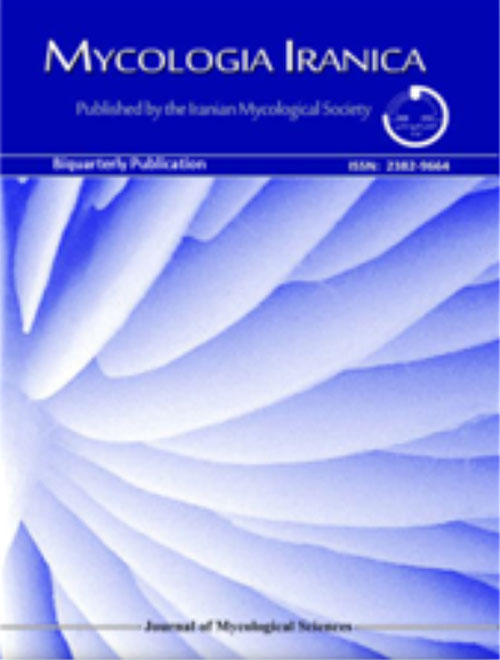فهرست مطالب

Mycologia Iranica
Volume:5 Issue: 2, Summer and Autumn 2018
- تاریخ انتشار: 1397/09/10
- تعداد عناوین: 7
-
-
Pages 53-61
Filamentous fungi Trichoderma spp. are efficient hyper-producers of industrially important enzymes. Xylanases are essential hemicellulases having vast ranges of applications in the various industrial sectors. In this study, the protoplast fusion of two T. virens and T. harzianum strains resulted in 2.5 Uml-1 xylanase activity in fusant X3 showing 4.7-fold improvement in xylanase activity compared to that of parents with 0.54 Uml-1. Moreover, to evaluate the influence of protoplast fusion on the xylanase activity, the expression patterns of the xylanase gene xyn3 was analyzed in the parental strains and the using qPCR. The results demonstrated that the relative expression of the xyn3 increased in X3 by 4.9 fold compared to that of the parents. Finally, based on the results, it could be concluded that the protoplast fusion technology is a promising approach to generate new superior fungi with high production ability of the industrially important enzymes.
Keywords: fungi, hemicellulases, Enzyme activity, qPCR -
Pages 63-70
Common and dwarf bunt of wheat are recognized as being caused by three closely related species, Tilletia caries and T. laevis as common bunt, and T. controversa as dwarf bunt. The morphological characteristics of two species including T. controversa and T. caries were studied from wheat grown in two provinces of Iran, Lorestan and Chaharmahal–o-Bakhtiari during 2014-2015. In this study, morphological characters could not completely distinguish these pathogens, as in some properties, they showed similarity to T. laevis. So, a collection of twenty wheat bunt isolates was used to compare species in morphological characteristics and phylogenetic relationships. Phylogenetic analyses were presented based on three PCR amplified nuclear DNA fragments including elongation factor 1 alpha (EF1α), the second largest subunit of RNA polymerase II (RPB2) genes and ITS-rDNA region. Maximum likelihood (ML) method was used to determine the phylogenetic relationship among isolates using MEGA v.6 and BEAUti and BEAST v1.6.1 software. Maximum likelihood bootstrap (BS) values and Bayesian posterior probabilities (PP) values were applied as criteria for strongly supported clades. Two species including T. controversa and T. caries were distinguished as different species with DNA sequence information.
Keywords: Morphology, multilocus phylogeny, Tilletia, EF1α, RPB2, ITS-rDNA -
Pages 71-77
Moldy Boletus sp. and Xerocomus sp. were collected from several locations at the campus of the University of Tabriz, Iran. Fungicolous fungal isolates were recovered and characterized by the combination of morphological traits and phylogenetic analyses of combined ITS and LSU sequence data. Fungal isolates were identified as Sepedonium microspermum. This is the first report of S. microspermum on Xerocomus sp. from Iran which is comprehensively described and illustrated.
Keywords: Morphology, ITS-rDNA, LSU, and Hypomyces -
Pages 79-89
Nine Dictyuchus isolates were obtained from floating and decaying twigs and leaves in Anzali lagoon, Anzali County, Guilan province, Iran. They are interestingly distinguished from current Dictyuchus species by the presence of dictyoid and achlyoid type of zoospore discharge, abundant fusiform and spherical gemma, and the absence of any sexual apparatus. In addition, phylogenetic analyses of the internal transcribed spacer (ITS) region of the nuclear rDNA and cytochrome c oxidase subunit I (cox1) gene sequences using Maximum likelihood method indicate its novelty. We preferred not to introduce the isolates as new species due to low number of and sometimes unreliable sequences and lack of type species and suggested to verify Dictyuchus sterilis which has been excluded before. We discussed about taxonomy of the genus in details and provided a revised key to the species. In addition, it was shown that sterility in vitro might be common in this genus.
Keywords: Biodiversity, freshwater ecosystems, oomycetes, Saprolegniales, sterility -
Pages 91-101
The purpose of this study was to identify the Fusarium species associated with selected medicinal plant species of Lamiaceae and Asteraceae in Kerman, the second-largest province of Iran. The plants showing wilting/rotting symptoms as well as asymptomatic plants were collected from main medicinal plants reservoirs and production areas. Fusarium species were identified based on morphological characteristics as well as subsequent sequencing of the translation elongation factor 1-alpha (TEF1-α gene. The following species were identified: F. oxysporum, F. solani and F. nygamai from Achillea wilhelmsii (Asteraceae); F. solani, F. proliferatum and species of F. tricinctum species complex from Teucrium polium (Lamiaceae); F. solani, F. proliferatum and species of F. tricinctum species complex from Ziziphora tenuior (Lamiaceae); F. solani and a species of F. tricinctum species complex from Thymus carmanicus (Lamiaceae); F. redolens, F. brachygibbosum, F. proliferatum, F. tricinctum species complex, F. compactum and F. equiseti from Mentha piperita (Lamiaceae); and F. solani and F. proliferatum from Ziziphora cliniopodiodes (Lamiaceae). For the first time, the pathogenicity of Fusarium nygamai on Achillea wilhelmsii as well as F. redolens and F. brachygibbosum on Mentha piperita were confirmed in this study.
Keywords: root rot, Rhizosphere microorganisms, Morphology, TEF1-ɑ -
Pages 103-104

